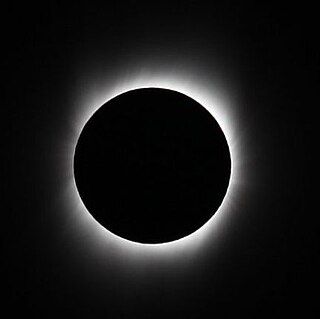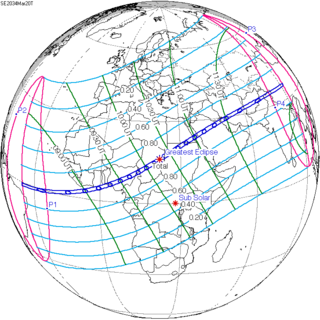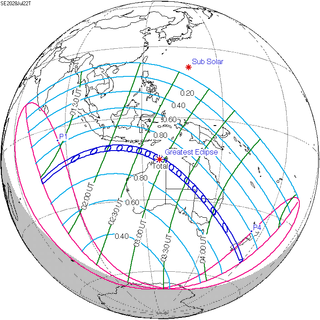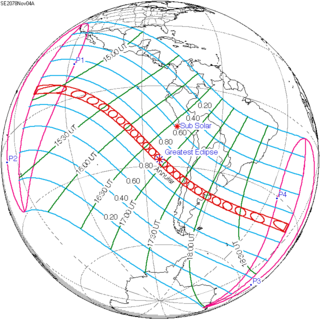
A total solar eclipse occurred at the Moon's descending node of the orbit on July 22, 2009, with a magnitude of 1.07991. It was the longest total solar eclipse during the 21st century; the longest total solar eclipse during the 3rd millennium will be on 16 July 2186. It lasted a maximum of 6 minutes and 38.86 seconds off the coast of Southeast Asia, causing tourist interest in eastern China, Pakistan, Japan, India, Nepal and Bangladesh. Its greatest magnitude was 1.07991, occurring only 6 hours, 18 minutes after perigee, with greatest eclipse totality lasting 6 minutes, 38.86 seconds during the Total Solar Eclipse of July 22, 2009.

An annular solar eclipse occurred at the Moon's descending node of the orbit on October 3, 2005, with a magnitude of 0.958. A solar eclipse occurs when the Moon passes between Earth and the Sun, thereby totally or partly obscuring the image of the Sun for a viewer on Earth. An annular solar eclipse occurs when the Moon's apparent diameter is smaller than the Sun's, blocking most of the Sun's light and causing the Sun to look like an annulus (ring). An annular eclipse appears as a partial eclipse over a region of the Earth thousands of kilometres wide. Occurring only 4.8 days after apogee, the Moon's apparent diameter was smaller. It was visible from a narrow corridor through the Iberian peninsula and Africa and Brazil. A partial eclipse was seen from the much broader path of the Moon's penumbra, including all of Europe, Africa and southwestern Asia. The Sun was 96% covered in a moderate annular eclipse, lasting 4 minutes and 32 seconds and covering a broad path up to 162 km wide. The next solar eclipse in Africa occurred just 6 months later.

A total lunar eclipse took place on 3 March 2007, the first of two eclipses in 2007. The Moon entered the penumbral shadow at 20:18 UTC, and the umbral shadow at 21:30 UTC. The total phase lasted between 22:44 UTC and 23:58 UTC with a distinctive brick-red shade. The Moon left the umbra shadow at 01:11 UTC and left the penumbra shadow at 02:24 UTC 2007-03-04. The second lunar eclipse of 2007 occurred on 28 August.

A total lunar eclipse occurred on February 20 and February 21, 2008. It was visible in the eastern evening sky on February 20 for all of North and South America, and on February 21 in the predawn western sky from most of Africa and Europe. Greatest Eclipse occurring on Thursday, February 21, 2008, at 03:26:03 UTC, totality lasting 49 minutes and 45.6 seconds.

A total lunar eclipse took place on Friday 16 May 2003, the first of two total lunar eclipses in 2003, the other being on 9 November 2003. A shallow total eclipse saw the Moon in relative darkness for 52 minutes and 3.1 seconds. The Moon was 12.938% of its diameter into the Earth's umbral shadow, and should have been significantly darkened. The partial eclipse lasted for 3 hours, 15 minutes and 3.1 seconds in total. Occurring only 0.5 days after perigee, the Moon's apparent diameter was 6.2% larger than average. At greatest eclipse the Moon was only 357,693 km from the Earth, making it a Super Full Moon.

A total lunar eclipse took place on Sunday 9 November 2003, the second of two total lunar eclipses in 2003, the first being on 16 May 2003. It is the first total lunar eclipse of 21st century which happened on a micromoon day. The Moon barely edged into total eclipse for 21 minutes and 58 seconds. With the Moon just 1.78% of its diameter into the Earth's umbral shadow, the Moon may have been quite bright, but even so, this should have been worth seeing. The partial eclipse lasted for 3 hours, 31 minutes and 25 seconds. Occurring only 1.4 days before apogee, the Moon's apparent diameter was 6.4% smaller than average.

A total lunar eclipse took place on Thursday 28 October 2004, the second of two total lunar eclipses in 2004, the first being on 4 May 2004. It was the first lunar eclipse to take place during a World Series game, which when seen from Busch Memorial Stadium in St, Louis, Missouri, provided a surreal sight on the night the Boston Red Sox won their first World Series in 86 years to end the Curse of the Bambino. Occurring 5.6 days before apogee, the Moon's apparent diameter was smaller. The Moon was 10.1 days after perigee and 5.6 days before apogee.

A penumbral lunar eclipse took place on Sunday 30 December 2001, the last of three lunar eclipses in 2001. At maximum eclipse, 89.477% of the Moon's disc was partially shaded by the Earth, which caused a slight shadow gradient across its disc; this subtle effect may have been visible to careful observers. No part of the Moon was in complete shadow. The eclipse lasted 4 hours, 4 minutes and 17.7 seconds overall. This lunar eclipse followed the Annular Solar Eclipse on 14 December 2001.

A total lunar eclipse took place on 4 April 2015. It is the former of two total lunar eclipses in 2015, and the third in a tetrad. Other eclipses in the tetrad are those of 15 April 2014, 8 October 2014, and 28 September 2015.

A total lunar eclipse will take place between Monday and Tuesday, June 25-26, 2029. A central total eclipse lasting 1 hour and 41 minutes 53 seconds will plunge the full Moon into deep darkness, as it passes right through the centre of the Earth's umbral shadow. While the visual effect of a total eclipse is variable, the Moon may be stained a deep orange or red color at maximum eclipse. It will be able to be seen from most of the Americas, Western Europe and Africa. The partial eclipse will last for 3 hours and 39 minutes 32 seconds in total.

A total lunar eclipse occurred at the Moon's descending node on 27 July 2018. The Moon passed through the center of Earth's shadow in what was the first central lunar eclipse since 15 June 2011. It was also the second total lunar eclipse in 2018, after the one on 31 January. It was the longest total lunar eclipse of the 21st century, but not the longest in the 3rd millennium. The longest total lunar eclipse of the 3rd millennium will occur on May 12, 2264, lasting 106 minutes and 13.2 seconds, which will be the longest total lunar eclipse since 2000, and the longest one until 3107.

A partial lunar eclipse will take place on November 30, 2039. At 3 hours 26 minutes, it is the longest partial lunar eclipse since November 19, 2021, which is the previous member of Lunar Saros 126.

A total solar eclipse will occur on Monday, March 20, 2034. A solar eclipse occurs when the Moon passes between Earth and the Sun, thereby totally or partly obscuring the image of the Sun for a viewer on Earth. A total solar eclipse occurs when the Moon's apparent diameter is larger than the Sun's, blocking all direct sunlight, turning day into darkness. Totality occurs in a narrow path across Earth's surface, with the partial solar eclipse visible over a surrounding region thousands of kilometres wide.

A total solar eclipse will occur over much of the central Eastern Hemisphere on Monday, August 2, 2027. It will commence over the eastern Atlantic Ocean and travel past the Strait of Gibraltar between Spain and Morocco. Totality will be visible in southern Spain as well as parts of North Africa and the Middle East, as well as the northern tip of the Horn of Africa. A partial eclipse visible in much of the Eastern Hemisphere. Major cities under the path will include Luxor in central Egypt, Jeddah and Mecca in southern Saudi Arabia, and Sana'a in southern Yemen. It will be the first of three total solar eclipses that are observable in Tunisia in the 21st century, passing over the central part of the country.

A hybrid solar eclipse occurred on Thursday, April 20, 2023. A solar eclipse occurs when the Moon passes between Earth and the Sun thereby totally or partly obscuring the Sun for a viewer on Earth. A hybrid solar eclipse is a rare type of solar eclipse that changes its appearance from annular to total and back as the Moon's shadow moves across the Earth's surface. Totality occurs in a narrow path across the surface of the Earth, with the partial solar eclipse visible over a surrounding region thousands of kilometers wide. Hybrid solar eclipses are extremely rare, occurring in only 3.1% of solar eclipses in the 21st century.

A total solar eclipse will occur on Saturday, July 22, 2028. The central line of the path of the eclipse will cross the Australian continent from the Kimberley region in the north west and continue in a south-easterly direction through Western Australia, the Northern Territory, south-west Queensland and New South Wales, close to the towns of Wyndham, Kununurra, Tennant Creek, Birdsville, Bourke and Dubbo, and continuing on through the centre of Sydney, where the eclipse will have a duration of over three minutes. It will also cross Queenstown and Dunedin, New Zealand. Totality will also be viewable from two of Australia's external territories: Christmas Island and Cocos (Keeling) Island.

An annular solar eclipse will occur on May 9, 2032. A solar eclipse occurs when the Moon passes between Earth and the Sun, thereby totally or partly obscuring the image of the Sun for a viewer on Earth. An annular solar eclipse occurs when the Moon's apparent diameter is smaller than the Sun's, blocking most of the Sun's light and causing the Sun to look like an annulus (ring). An annular eclipse appears as a partial eclipse over a region of the Earth thousands of kilometres wide.

An annular solar eclipse will occur on Friday, November 4, 2078. A solar eclipse occurs when the Moon passes between Earth and the Sun, thereby totally or partly obscuring the image of the Sun for a viewer on Earth. An annular solar eclipse occurs when the Moon's apparent diameter is smaller than the Sun's, blocking most of the Sun's light and causing the Sun to look like an annulus (ring). An annular eclipse appears as a partial eclipse over a region of the Earth thousands of kilometres wide. The path of annularity will cross Pacific Ocean, South America, and Atlantic Ocean. The tables below contain detailed predictions and additional information on the Annular Solar Eclipse of 4 November 2078.

A total solar eclipse will occur on Monday, August 24, 2082. A solar eclipse occurs when the Moon passes between Earth and the Sun, thereby totally or partly obscuring the image of the Sun for a viewer on Earth. A total solar eclipse occurs when the Moon's apparent diameter is larger than the Sun's, blocking all direct sunlight, turning day into darkness. Totality occurs in a narrow path across Earth's surface, with the partial solar eclipse visible over a surrounding region thousands of kilometres wide.

A total lunar eclipse will occur on Wednesday, June 9, 2123, with maximum eclipse at 05:06 UTC. A dramatic total eclipse lasting 106 minutes and 6 seconds will plunge the full Moon into deep darkness, as it passes right through the centre of the Earth's umbral shadow. While the visual effect of a total eclipse is variable, the Moon may be stained a deep orange or red colour at maximum eclipse. This will be a great spectacle for everyone who sees it. The partial eclipse will last for 3 hours and 56 minutes in total. The penumbral eclipse lasts for 6 hours and 14 minutes. Maximum eclipse is at 05:06:28 UT. This will be the longest Total Lunar Eclipse since 16 July 2000, and the longest one until 12 May 2264 and 27 July 3107, though the eclipse on June 19, 2141 will be nearly identical in all aspects. This will also be the longest of the 22nd century and the second longest of the 3rd millennium. The eclipse on June 19, 2141 will be the second longest of the 22nd century and the third longest of the third millennium.








































